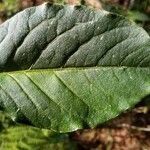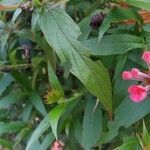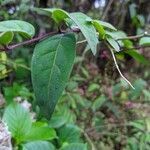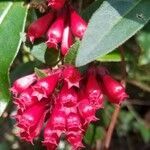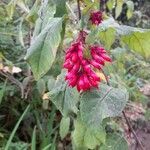Woody shrub to 3 m high, all parts pubescent. Leaves broadly lanceolate; lamina 6–17 cm long, 2–9 cm wide, pubescent; petiole 10–30 mm long. Inflorescence a congested, terminal panicle of subspicate racemes, densely pubescent with purple hairs; flowers numerous, sessile or on pedicels 0.5 mm long, the lower ones subtended by lanceolate, often coloured, bracts. Calyx 6–8 mm long; lobes triangular-acuminate, to 3 mm long. Corolla reddish; tube 15–20 mm long, 1–1.5 mm diam. at base, expanded to 5 mm at apex; lobes 2.5–4 mm long. Stamens inserted just below middle of corolla-tube; filaments 10 mm long, swollen and sparsely pubescent at base; anthers 1–1.5 mm long. Style c. 17 mm long. Berry more or less globular, c. 10 mm diam., red. Seeds not known.
Shrubs. Stem copiously pubescent. Petiole 6-12 mm; leaf blade ovate or elliptic, ca. 8 × 3 cm. Inflorescences erect, terminal or axillary, congested racemose panicles; bracts ovate, minutely tomentose, 4-5 mm. Flowers odorless. Pedicel ca. 1 mm. Calyx narrowly campanulate, 6-8 mm, glabrous, unribbed; teeth ca. 3 mm, ciliate. Corolla red, pink, or violet, ca. 2 cm, expanded upward, abruptly contracted at throat, glabrous; lobes deltoid, ca. 2 mm. Filaments glabrous, unappendaged, slightly bent at point of insertion. Fruiting calyx not splitting. Berry dark pink, globose, 0.8-1.3 cm. Seeds ca. 8.
Small tree or climbing shrub, up to 2 m high. Young branches hairy. Leaves ovate to ovate-lanceolate, up to 130 mm long, acute to acuminate. Inflorescence a loose terminal cluster, nodding. Calyx 6 mm long. Corolla 15-22 mm long, constricted near mouth. Berries red. Flowers crimson to reddish purple.
